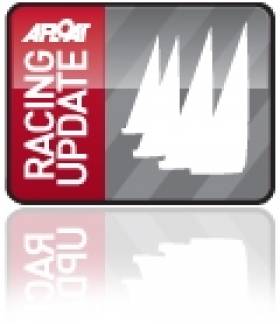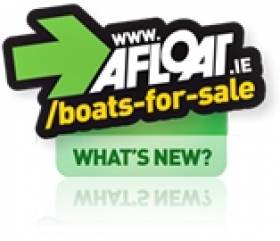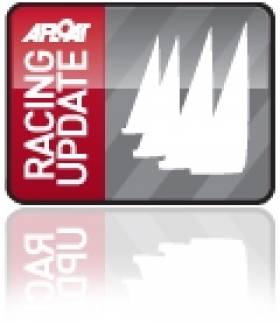Displaying items by tag: Half Ton Cup
#halftonclasics – Stunning, is the best way to describe the opening day of the 2014 Half Ton Classics Cup in Saint-Quay-Portriuex on the north coast of Brittany writes Fiona Brown. The weather offered something for everyone including plenty of sunshine and a range of wind conditions, the race management provided three great windward leeward races, and the Half Tonners and their crews excelled themselves by providing seat of the pants racing all day.
It is clear that the level of competition in the 22-strong fleet has taken a significant leap forward this year. After racing Richard Hollis of Crakajax, an X-95 production Half Tonner from Cowes, which has competed in many of the Half Ton Classics events, noted; "It's much tougher this year. The racing is extremely close. Just one small mistake and you loose several places. The quality of the sailing in outstanding." This was borne out by the results where the boats were frequently separated by mere seconds on corrected time and a different boat won each race. Race one went to Francis Marshall's 1989 Andrieu designed Concord, race two to Bernard Fournier Le Ray's Brittany Drizzel, a 1978 Berrett design, and race three to Peter Morton's beautifully refitted 1977 Farr designed Swuzzlebubble.
With three races completed fleet newcomer Peter Morton, better known as the man who revived the Quarter Tonners and who won his fourth revived Quarter Ton Cup just a fortnight ago, is leading the fleet. Swuzzlebubble is something of a legend among Half Tonners and this is her first serious outing at a Half Ton Classics event. Despite being the new kids on the block Peter and his very experienced crew laid down a 2, 2, 1 score as they found their feet in the boat. Two points behind in second place overall is Bernard Fournier Le Ray's Brittany Drizzle, which has achieved great success in her home port of La Trinite. In third place overall on 20 points is the 1980 Joubert-Nivelt designed Sibelius, owned by Claude Charbonnier who is also based in La Trinite and is another regular on the Half Ton circuit. Philippe Pilate's General Tapioca (1978 Jean Berret) is in fourth place with 21 points and Toni Stoschek's Superhero (1988 Andrieu), Nigel Biggs' Checkmate XV (1985 Humphries) and David Evans' Hullaballoo XV are all tied for fifth on 23 points. Hullaballoo XV is a 1978 Stephen Jones designed Hustler 32 and as such she is also the leading boat in the Series Division for production Half Tonners.
The different race winners also represented very different approaches to Half Ton campaigning. Whilst all the boats in the fleet are immaculately maintained there are some who take a strictly traditional approach, retaining their runners and checkstays and keeping their deck layouts as original, while others choose to modernise the boats as much as is possible within the confines of the strict class rules.
Winner of race one Francis Marshall is definitely an owner who takes a classic approach in regard to Concord, his carbon composite and full titanium Half Tonner which he campaigns with a bunch of Enterprise dinghy sailing friends from Loo in Cornwall. When Francis purchased Concord in 2008 she had been fitted with a small swept back spreader rig and much of the original titanium had been removed. Francis painstakingly restored the entire boat including replacing all the titanium and she is now in perfect as original condition. Their win in today's first race was a nice book end moment for Francis and Concord as they also won the final race of the 2011 Half Ton Classics Cup in Cowes, which was her last serious racing outing. Francis explained; "Concord has been in a lorry park so she hasn't been sailed since Cowes. We launched her in Plymouth about a month ago and sailed four Wednesday nights in training for this, although we didn't quite manage to get all the crew on the boat at the same time until we came here. So we were quite pleased with that first race and it all came together well!"
Swuzzelbubble represents the opposite end of the refit spectrum and has been extensively optimised for IRC with a swept back spreader rig and a fully modernised deck layout. Rob Lark, tactician aboard Swuzzlebubble, acknowledged that the boats with a more modern rig and deck layout do have some advantages, particularly in close tacking duels when the need for extra time to change runners can make all the difference to a boat, as Brittany Drizzle, who retains her runners and checks, found out when they engaged in a tacking duel with Swuzzlebubble on the second beat of race two.
This evening the crews enjoyed a rousing prize giving in the Half Ton Classics Cup Regatta Marquee, cheering loudly for each boat as their name and finish position in the racing was called out. The three race winners were called to the podium and presented with specially engraved Harken winch handles.
Tomorrow the boats will take part in a short offshore race starting at 10.00 that will take them around l'Ile de Brehat, a stunningly beautiful archipelago of pink granite islands that lie a mile off the Brittany coast and some 25 miles to the north west of Saint-Quay-Portrieux. The regatta continues until Friday.
Irish Half Ton Cup Contender 'King One' Goes Up for Sale
#boatsforsale – King One, the Howth Yacht Club based Half tonner that has competed for Ireland with success at Ramsgate week, the Isle of Wight and the Half ton Cup, is up for sale at €29,950. Skipper Dave Cullen, who won a string of trophies in the 1981 Half Ton Cup winner has updated the Modified Berret hull recent years. Now a 'serious contender' for the Cup again the boat has had over €100k spent recently. Its 2014 IRC handicap is 0.953 and the yacht has a new Mark MIlls keel together with a new carbon Jason Ker rudder and tiller.
The GRP hull was stripped and faired just last season and also in 2013 Seatek racing stanchions and pulpit were fitted.
Please click to view the full King One advert on Afloat boats for sale plus hundreds more yachts, motorboats and dinghies currently for sale.
Half Tonner Checkmate Wins Classic Cup in Boulogne Sur Mer
#halftoncup – The Half Ton Classic Cup in Boulogne Sur Mer was convincingly won by July's Dun Laoghaire Volvo regatta winner, Checkmate (Nigel Biggs) sailing under the Royal St. George Yacht Club burgee with a succession of race wins.
Recently W M Nixon followed the winding path which has led through various attempts at creating offshore one designs into the success of the Ton Cup categories, and their recent revival as classics using the IRC handicap system - just like everyone else.
Also competing in France was Howth Yacht Club's King One. Having broken her mast in Cowes in the last event when leading the pack, there was a greater enthusiasm to return to the fleet with a bang. Winds varied from 5 to 20 knots during the week with glorious sunshine and temperatures except for a gloomy wet grey day on the Thursday of the event.
Lying a solid fourth in the 28–boat fleet on the Wednesday evening, this gloom extended to King One when they were black flagged on the double point non discardable offshore which put pay to any chance of a decent overall result. Ironically, the boat that pushed King One over the line at the start also was disqualified for being over.































































